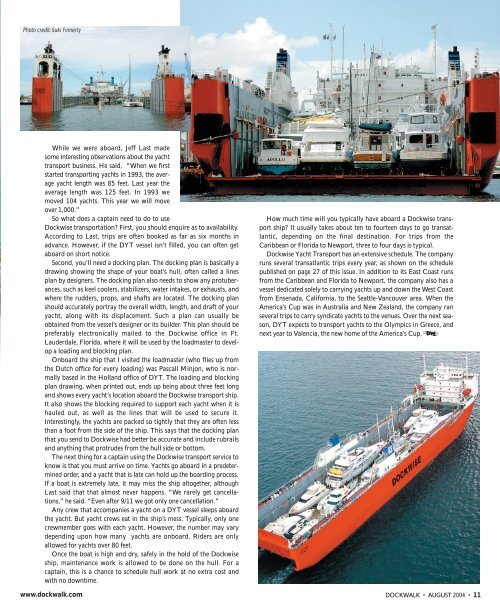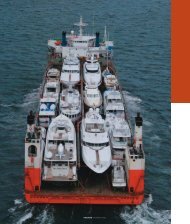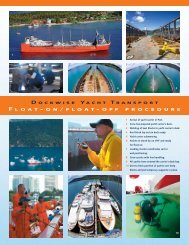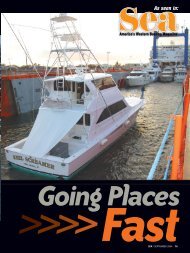Dockwalk article, August 2004 - Dockwise Yacht Transport
Dockwalk article, August 2004 - Dockwise Yacht Transport
Dockwalk article, August 2004 - Dockwise Yacht Transport
- No tags were found...
Create successful ePaper yourself
Turn your PDF publications into a flip-book with our unique Google optimized e-Paper software.
Photo credit: Suki FinnertyWhile we were aboard, Jeff Last madesome interesting observations about the yachttransport business. He said, “When we firststarted transporting yachts in 1993, the averageyacht length was 85 feet. Last year theaverage length was 125 feet. In 1993 wemoved 104 yachts. This year we will moveover 1,000.”So what does a captain need to do to use<strong>Dockwise</strong> transportation? First, you should enquire as to availability.According to Last, trips are often booked as far as six months inadvance. However, if the DYT vessel isn’t filled, you can often getaboard on short notice.Second, you’ll need a docking plan. The docking plan is basically adrawing showing the shape of your boat’s hull, often called a linesplan by designers. The docking plan also needs to show any protuberances,such as keel coolers, stabilizers, water intakes, or exhausts, andwhere the rudders, props, and shafts are located. The docking planshould accurately portray the overall width, length, and draft of youryacht, along with its displacement. Such a plan can usually beobtained from the vessel’s designer or its builder. This plan should bepreferably electronically mailed to the <strong>Dockwise</strong> office in Ft.Lauderdale, Florida, where it will be used by the loadmaster to developa loading and blocking plan.Onboard the ship that I visited the loadmaster (who flies up fromthe Dutch office for every loading) was Pascall Minjon, who is normallybased in the Holland office of DYT. The loading and blockingplan drawing, when printed out, ends up being about three feet longand shows every yacht’s location aboard the <strong>Dockwise</strong> transport ship.It also shows the blocking required to support each yacht when it ishauled out, as well as the lines that will be used to secure it.Interestingly, the yachts are packed so tightly that they are often lessthan a foot from the side of the ship. This says that the docking planthat you send to <strong>Dockwise</strong> had better be accurate and include rubrailsand anything that protrudes from the hull side or bottom.The next thing for a captain using the <strong>Dockwise</strong> transport service toknow is that you must arrive on time. <strong>Yacht</strong>s go aboard in a predeterminedorder, and a yacht that is late can hold up the boarding process.If a boat is extremely late, it may miss the ship altogether, althoughLast said that that almost never happens. “We rarely get cancellations,”he said. “Even after 9/11 we got only one cancellation.”Any crew that accompanies a yacht on a DYT vessel sleeps aboardthe yacht. But yacht crews eat in the ship’s mess. Typically, only onecrewmember goes with each yacht. However, the number may varydepending upon how many yachts are onboard. Riders are onlyallowed for yachts over 80 feet.Once the boat is high and dry, safely in the hold of the <strong>Dockwise</strong>ship, maintenance work is allowed to be done on the hull. For acaptain, this is a chance to schedule hull work at no extra cost andwith no downtime.www.dockwalk.comHow much time will you typically have aboard a <strong>Dockwise</strong> transportship? It usually takes about ten to fourteen days to go transatlantic,depending on the final destination. For trips from theCaribbean or Florida to Newport, three to four days is typical.<strong>Dockwise</strong> <strong>Yacht</strong> <strong>Transport</strong> has an extensive schedule. The companyruns several transatlantic trips every year, as shown on the schedulepublished on page 27 of this issue. In addition to its East Coast runsfrom the Caribbean and Florida to Newport, the company also has avessel dedicated solely to carrying yachts up and down the West Coastfrom Ensenada, California, to the Seattle-Vancouver area. When theAmerica’s Cup was in Australia and New Zealand, the company ranseveral trips to carry syndicate yachts to the venues. Over the next season,DYT expects to transport yachts to the Olympics in Greece, andnext year to Valencia, the new home of the America’s Cup.DOCKWALK • AUGUST <strong>2004</strong> • 11








